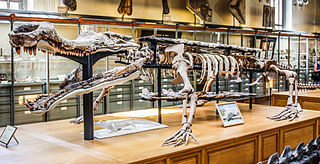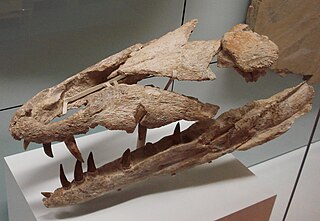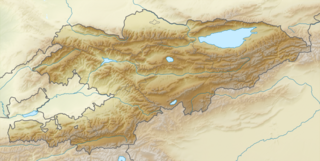Related Research Articles

Sarcosuchus is an extinct genus of crocodyliform and distant relative of living crocodylians that lived during the Early Cretaceous, from the late Hauterivian to the early Albian, 133 to 112 million years ago of what is now Africa and South America. It was one of the largest crocodile-line reptiles, reaching an average estimate of 9 m (30 ft) and 3.5 metric tons, but estimated to grow up to 9.5 m (31 ft) in body length and weigh up to 4.3 metric tons. It is known from two species, S. imperator from the early Albian Elrhaz Formation of Niger and S. hartti from the Late Hauterivian of northeastern Brazil, other material is known from Morocco and Tunisia and possibly Libya and Mali.

Deinosuchus is an extinct genus of crocodilian related to the modern alligator that lived 82 to 73 million years ago (Ma), during the late Cretaceous period. The name translates as "terrible crocodile" and is derived from the Greek deinos (δεινός), "terrible", and soukhos (σοῦχος), "crocodile". The first remains were discovered in North Carolina in the 1850s; the genus was named and described in 1909. Additional fragments were discovered in the 1940s and were later incorporated into an influential, though inaccurate, skull reconstruction at the American Museum of Natural History. Knowledge of Deinosuchus remains incomplete, but better cranial material found in recent years has expanded scientific understanding of this massive predator.

Dakosaurus is an extinct genus of crocodylomorph within the family Metriorhynchidae that lived during the Late Jurassic and Early Cretaceous. It was large, with teeth that were serrated and compressed lateromedially. The genus was established by Friedrich August von Quenstedt in 1856 for an isolated tooth named Geosaurus maximus by Plieninger. Dakosaurus was a carnivore that spent much, if not all, its life out at sea. The extent of its adaptation to a marine lifestyle means that it is most likely that it mated at sea, but since no eggs or nests have been discovered that have been referred to Dakosaurus, whether it gave birth to live young at sea like dolphins and ichthyosaurs or came ashore like turtles is not known. The name Dakosaurus means "biter lizard", and is derived from the Greek dakos ("biter") and σαῦρος -sauros ("lizard").

Goniopholis is an extinct genus of goniopholidid crocodyliform that lived in Europe and Africa during the Late Jurassic and Early Cretaceous. Being semi-aquatic it is very similar to modern crocodiles. It ranged from 2–4 metres in length, and would have had a very similar lifestyle to the American alligator or Nile crocodile.
Ferganasaurus was a genus of dinosaur first formally described in 2003 by Alifanov and Averianov. The type species is Ferganasaurus verzilini. It was a sauropod similar to Rhoetosaurus. Ferganasaurus is known exclusively from the Balabansai Formation of Kyrgyzstan, which dates to the Callovian stage of the Middle Jurassic.

Sphenosuchus is an extinct genus of crocodylomorph from the Early Jurassic Elliot Formation of South Africa, discovered and described early in the 20th century. The skull is preserved very well but other than elements of the forelimb and isolated parts of the hind limb, the Sphenosuchus material is incomplete. It was probably quadrupedal, but may have been a facultative biped.

Geosaurus is an extinct genus of marine crocodyliform within the family Metriorhynchidae, that lived during the Late Jurassic and the Early Cretaceous. Geosaurus was a carnivore that spent much, if not all, its life out at sea. No Geosaurus eggs or nests have been discovered, so little is known of the reptile's lifecycle, unlike other large marine reptiles of the Mesozoic, such as plesiosaurs or ichthyosaurs which are known to give birth to live young out at sea. Where Geosaurus mated, whether on land or at sea, is currently unknown. The name Geosaurus means "Mother of Giants lizard", and is derived from the Greek Ge- and σαῦρος -sauros ("lizard"). The name Geosaurus was established by the French naturalist Georges Cuvier in 1824.
Trematochampsa is a dubious extinct genus of crocodyliform from the Late Cretaceous In Beceten Formation of Niger.
Cricosaurus is an extinct genus of marine crocodyliforms of the Late Jurassic, belonging to the family Metriorhynchidae. The genus was established by Johann Andreas Wagner in 1858 for three skulls from the Tithonian of Germany. The name Cricosaurus means "Ring lizard", and is derived from the Greek Cricos- ("ring") and σαῦρος -sauros ("lizard").
Calsoyasuchus is a genus of goniopholidid mesoeucrocodylian that lived in the Early Jurassic. Its fossilized remains were found in the Sinemurian-Pliensbachian-age Kayenta Formation on Navajo Nation land in Coconino County, Arizona, United States. Formally described as C. valliceps, it is known from a single incomplete skull which is unusually derived for such an early crocodile relative. This genus was described in 2002 by Ronald Tykoski and colleagues; the species name means "valley head" and refers to a deep groove along the midline of the nasal bones and frontal bones.
Goniopholididae is an extinct family of moderate-sized semi-aquatic crocodyliforms superficially similar to living crocodiles. They lived between the Early Jurassic and the Late Cretaceous.
Eutretauranosuchus is an extinct genus of goniopholidid crocodyliform. E. delfsi is the only known species within the genus.

Bergisuchus is an extinct genus of small sebecosuchian mesoeucrocodylian known primarily from the Eocene Messel Pit in Germany. Few fossils of Bergisuchus have been discovered, only a single incomplete snout, a few partial lower jaws and some teeth. Despite being fragmentary, the jaw bones are enough to indicate that Bergisuchus had a short, deep, narrow snout and serrated teeth, quite unlike the broad flat snouts of modern crocodylians.
Eopneumatosuchus is an extinct genus of basal crocodyliform. Fossils have been found from two localities within the Kayenta Formation of Arizona. Both localities are around 20 miles southeast of the Grand Canyon and in close proximity to one another. The localities probably date back to the Early Jurassic, most likely during the Sinemurian stage.

The Ialovachsk or Yalovach Formation is a Santonian geologic formation in Kyrgyzstan, Tajikistan and Uzbekistan. Fossil dinosaur eggs have been reported from the formation.
Platyognathus is an extinct genus of protosuchian crocodylomorph. Fossils are known from the Early Jurassic Lower Lufeng Formation in Yunnan, China and belong to the type and only species, P. hsui.
Sunosuchus is an extinct genus of goniopholidid mesoeucrocodylian. Fossils are known from China, Kyrgyzstan, and Thailand and are Jurassic in age, although some may be Early Cretaceous. Four species are currently assigned to the genus: the type species S. miaoi and the species S. junggarensis, S. shartegensis, and S. shunanensis. All species are from China. Goniopholis phuwiangensis, also from Thailand, was reassigned to Sunosuchus by Andrade et al. (2011). The material from Kyrgyzstan has not been assigned to any species.
Shantungosuchus is an extinct genus of Early Cretaceous crocodyliform found in China. It includes three species: Shantungosuchus chuhsienensis and S. brachycephalus, which were both described by Yang Zhongjian – usually referred to as "Young" – in 1961 and 1982, and S. hangjinensis, which was described by Xiao-Chun Wu et al in 1994. S. chuhsienensis is the type for this genus.

Chalawan is an extinct genus of pholidosaurid mesoeucrocodylian known from the Early Cretaceous Phu Kradung Formation of Nong Bua Lamphu Province, northeastern Thailand. It contains a single species, Chalawan thailandicus, with Chalawan shartegensis as a possible second species.

Thalattosuchus is an extinct genus of marine crocodyliform that lived in the oceans during the Middle to Late Jurassic. Thalattosuchus was named in 2020. Thalattosuchus was a carnivore that spent much, if not all, its life out at sea. No Thalattosuchus eggs or nests have been discovered, so little is known of the reptile's life cycle, unlike other large marine reptiles of the Mesozoic, such as plesiosaurs or ichthyosaurs which are known to have given birth to live young out at sea. Where Thalattosuchus mated, whether on land or at sea, is currently unknown. The name Thalattosuchus means "sea crocodile".
References
- ↑ Nessov, L. A. (1990). "Late Jurassic labyrinthodont (Amphibia, Labyrinthodontia) among other relict vertebrate groups in northern Fergana". Paleontologicheskii Zhurnal. 3: 82–90.
- 1 2 Averianov, A. O. (2000). "Sunosuchus sp. (Crocodylomorpha, Goniopholididae) from the Middle Jurassic of Kirghisia". Journal of Vertebrate Paleontology. 20 (4): 776–779. doi:10.1671/0272-4634(2000)020[0776:SSCGFT]2.0.CO;2.
- 1 2 Nessov, L. A.; Kaznyshkina, L. F.; Cherepanov, G. O. (1989). "Mesozoic dinosaurians-ceratopses and crocodiles of Central Asia". In Bogdanova, T. N.; Khozatsky, L. I. (eds.). Theoretical and Applied Aspects of Modern Paleontology. Leningrad: Nauka. pp. 144–154.